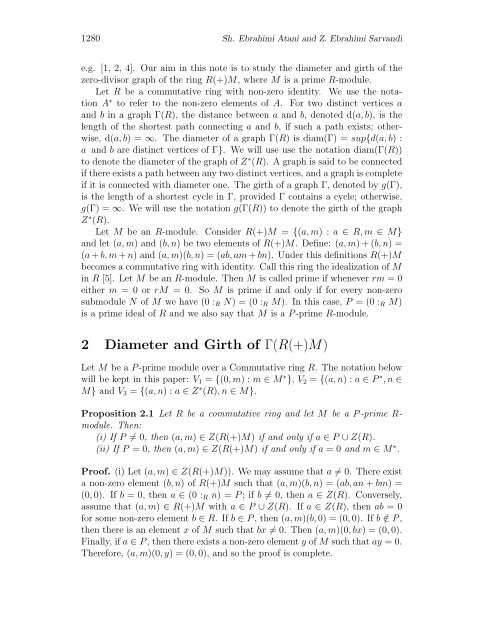Zero-Divisor Graphs of Idealizations with Respect to Prime Modules ...
Zero-Divisor Graphs of Idealizations with Respect to Prime Modules ...
Zero-Divisor Graphs of Idealizations with Respect to Prime Modules ...
You also want an ePaper? Increase the reach of your titles
YUMPU automatically turns print PDFs into web optimized ePapers that Google loves.
1280 Sh. Ebrahimi Atani and Z. Ebrahimi Sarvandi<br />
e.g. [1, 2, 4]. Our aim in this note is <strong>to</strong> study the diameter and girth <strong>of</strong> the<br />
zero-divisor graph <strong>of</strong> the ring R(+)M, where M is a prime R-module.<br />
Let R be a commutative ring <strong>with</strong> non-zero identity. We use the notation<br />
A ∗ <strong>to</strong> refer <strong>to</strong> the non-zero elements <strong>of</strong> A. For two distinct vertices a<br />
and b in a graph Γ(R), the distance between a and b, denoted d(a, b), is the<br />
length <strong>of</strong> the shortest path connecting a and b, if such a path exists; otherwise,<br />
d(a, b) =∞. The diameter <strong>of</strong> a graph Γ(R) is diam(Γ) = sup{d(a, b) :<br />
a and b are distinct vertices <strong>of</strong> Γ}. We will use use the notation diam(Γ(R))<br />
<strong>to</strong> denote the diameter <strong>of</strong> the graph <strong>of</strong> Z ∗ (R). A graph is said <strong>to</strong> be connected<br />
if there exists a path between any two distinct vertices, and a graph is complete<br />
if it is connected <strong>with</strong> diameter one. The girth <strong>of</strong> a graph Γ, denoted by g(Γ),<br />
is the length <strong>of</strong> a shortest cycle in Γ, provided Γ contains a cycle; otherwise,<br />
g(Γ) = ∞. We will use the notation g(Γ(R)) <strong>to</strong> denote the girth <strong>of</strong> the graph<br />
Z ∗ (R).<br />
Let M be an R-module. Consider R(+)M = {(a, m) :a ∈ R, m ∈ M}<br />
and let (a, m) and (b, n) be two elements <strong>of</strong> R(+)M. Define: (a, m)+(b, n) =<br />
(a + b, m + n) and (a, m)(b, n) =(ab, am + bn). Under this definitions R(+)M<br />
becomes a commutative ring <strong>with</strong> identity. Call this ring the idealization <strong>of</strong> M<br />
in R [5]. Let M be an R-module. Then M is called prime if whenever rm =0<br />
either m =0orrM =0. SoM is prime if and only if for every non-zero<br />
submodule N <strong>of</strong> M we have (0 :R N) = (0 :R M). In this case, P =(0:R M)<br />
is a prime ideal <strong>of</strong> R and we also say that M is a P -prime R-module.<br />
2 Diameter and Girth <strong>of</strong> Γ(R(+)M)<br />
Let M be a P -prime module over a Commutative ring R. The notation below<br />
will be kept in this paper: V1 = {(0,m):m ∈ M ∗ }, V2 = {(a, n) :a ∈ P ∗ ,n∈<br />
M} and V3 = {(a, n) :a ∈ Z ∗ (R),n∈ M}.<br />
Proposition 2.1 Let R be a commutative ring and let M be a P -prime Rmodule.<br />
Then:<br />
(i) If P = 0, then (a, m) ∈ Z(R(+)M) if and only if a ∈ P ∪ Z(R).<br />
(ii) If P =0, then (a, m) ∈ Z(R(+)M) if and only if a =0and m ∈ M ∗ .<br />
Pro<strong>of</strong>. (i) Let (a, m) ∈ Z(R(+)M)). We may assume that a = 0. There exist<br />
a non-zero element (b, n) <strong>of</strong>R(+)M such that (a, m)(b, n) =(ab, an + bm) =<br />
(0, 0). If b = 0, then a ∈ (0 :R n) =P ;ifb = 0, then a ∈ Z(R). Conversely,<br />
assume that (a, m) ∈ R(+)M <strong>with</strong> a ∈ P ∪ Z(R). If a ∈ Z(R), then ab =0<br />
for some non-zero element b ∈ R. Ifb ∈ P , then (a, m)(b, 0) = (0, 0). If b/∈ P ,<br />
then there is an element x <strong>of</strong> M such that bx = 0. Then (a, m)(0,bx)=(0, 0).<br />
Finally, if a ∈ P , then there exists a non-zero element y <strong>of</strong> M such that ay =0.<br />
Therefore, (a, m)(0,y)=(0, 0), and so the pro<strong>of</strong> is complete.
















